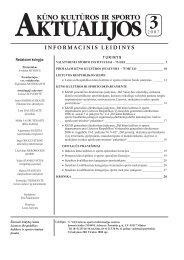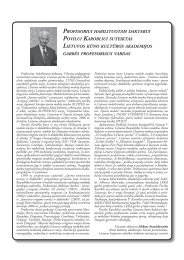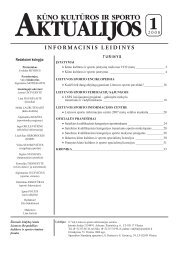Nr. 3 - Lietuvos sporto informacijos centras
Nr. 3 - Lietuvos sporto informacijos centras
Nr. 3 - Lietuvos sporto informacijos centras
Create successful ePaper yourself
Turn your PDF publications into a flip-book with our unique Google optimized e-Paper software.
2012 <strong>Nr</strong>. 3(69)<br />
41<br />
Psycho-sociological conditions of women’s sports<br />
Introduction<br />
In modern societies, sport was usually reserved<br />
for young men representing the middle and higher<br />
classes (Heinemann, 1998). The post-modern culture<br />
has broken those stereotypes, which contributed to<br />
the democratisation of sport and thus let it become<br />
more open and accessible also for other social layers<br />
and groups, especially for women.<br />
Prof. Halina Zdebska<br />
University School of Physical Education, Kraków, Poland<br />
Summary<br />
As an element of mass culture, sport plays important social roles, creating an entire range of behavioural models.<br />
Sportspeople represent the efficiency of actions, persistence in aiming at their goals, conscientiousness, diligence and<br />
physical perfection. They are successful people and their success brings them fame, prestige and money.<br />
What are the expectations towards women’s sports? Is it about encouraging competition among an ever-growing<br />
number of women who would achieve results comparable to those of men? Or is it about gender competition, aimed<br />
at showing that the idea of fight, traditionally reserved for men, may also become women’s domain? The answer to<br />
those questions is quite simple – women want to win, too. The aims of women’s sports are exactly the same as those<br />
associated with men’s sports: achieving better and better results, crossing barriers, generating the best show possible<br />
in order to attract thousands of spectators. Apart from the morpho-functional conditions for women who practice<br />
professional sports, the psychosocial context of the phenomenon also seems to be very important.<br />
The hypothesis saying that sport belongs to the men’s world, quite popular in sociology and psychology, is<br />
unjustified. For many years, an athlete has been associated with features typical for the stereotype of masculinity:<br />
in a good physical shape, dominating, independent, focused on success, making decisions easily, charismatic, open<br />
to the world of external events, rigid in his beliefs, demanding, cheerful. At the opposite pole, there is the stereotype<br />
of femininity, picturing women mainly as sensitive, caring, thoughtful, gentle, coquettish, caring about their looks,<br />
having a sense of aesthetics, affectionate, economical, emotional, sensitive to the needs of others, capable of making<br />
sacrifices, soft, naive and gossiping (Kuczyńska, 1992). Therefore, the typical feminine features are not useful in<br />
sports, whereas athletes represent what a “real man” should be.<br />
The aim of this paper is to try to depict the selected aspects of women’s participation in today’s professional<br />
sports, with a special focus on the following: cultural stereotypes that influence women’s situation in sport, gender<br />
asymmetry in media broadcasting, becoming a professional sportsperson and the accessibility of the profession of<br />
coach, as well as the specificity of women’s sports training (especially regarding the skills of coaches who work with<br />
women). The paper analyses some Polish publications in the field of psychology, sociology, pedagogy and theory of<br />
sports (among others, publications by Żukowska, Żukowski, Dąbrowska, Kamień, Dracz, Kuczyńska, Mikołajczyk,<br />
Lenartowicz, Czerwiński), enhanced with the results of studies conducted by American psychologists (including<br />
Knoppers, Humberstone and Staurowsky), as well as with the opinions by some eminent coaches who used to work<br />
with the Polish national basketball and volleyball teams.<br />
The basic research technique the subject of this paper was approached with is the content analysis, which was<br />
defined by Berelson as “a research technique for the objective, systematic, and quantitative description of manifest<br />
content of communications” (Pilch, 1977, p. 145).<br />
The results of the analyses confirmed that asking about the gender of sports, which is mostly the consequence of<br />
cultural stereotypes, is unjustified, and also confirmed that it is necessary to continue to overcome them. This can be<br />
done if countries adopt relevant social policies and laws in order to treat all people equally (regardless of their sex,<br />
race, beliefs etc.).<br />
Overcoming stereotypes is especially important for the social roles of women (especially to enable them to reach<br />
self-fulfilment in sports and beyond sports) and their participation in sports groups dominated by men (which could<br />
make their needs better articulated and understood). This stems from the fact that sportswomen have rejected the<br />
model of a passive and subordinate woman, and the concept of femininity preferred by them can be reconciled with<br />
sports. The asymmetry in the presence of both sexes in sports is the most visible in the employment of coaches. Female<br />
coaches are the majority in very few disciplines, and in some they are not present at all. Their particular role is usually<br />
highlighted in children’s and youth sports, as well as in sports disciplines dominated by women.<br />
While educating coaches and instructors, it is very important to pay attention to the specificity of working with<br />
women and to consider the expectations they have from their coaches (which differ from the expectations of male<br />
sportspeople).<br />
Keywords: sports, women, coach, psychology, sociology .<br />
What are the expectations towards women’s<br />
sport? The answer to those questions is quite simple –<br />
women want to win, too. The aims of women’s sport<br />
are exactly the same as those associated with men’s<br />
sport: achieving better and better results, crossing<br />
barriers and generating the best show possible in<br />
order to attract thousands of spectators.
















